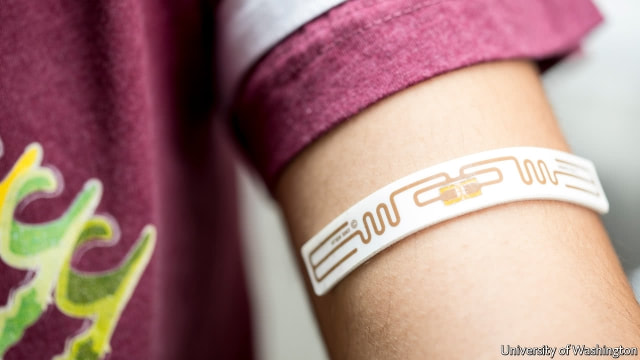THE word “smart” is ubiquitous these days. If you believe the hype, smart farms will all employ sensors to report soil conditions, crop growth or the health of livestock. Smart cities will monitor the levels of pollution and noise on every street corner. And smart goods in warehouses will tell robots where to store them, and how. Getting this to work, however, requires figuring out how to get thousands of sensors to transmit data reliably across hundreds of metres. On September 15th, at a computing conference held in Miami, Shyam Gollakota and his colleagues at the University of Washington are due to unveil a gadget that can do exactly that—and with only a fraction of the power required by the best devices currently available.
Dr Gollakota’s invention uses a technology called “LoRa” (from “long range”). Like Wi-Fi, this allows computers to talk to each other with radio waves. Unlike Wi-Fi, though, LoRa is not easily blocked by walls, furniture and other obstacles. That is partly because LoRa uses lower-frequency radio waves than Wi-Fi (900MHz rather than 2.4GHz). Such waves pass through objects more easily. More importantly, LoRa devices make use of a technique called “chirp spread modulation”. That means the frequency of the carrier wave—the basic radio wave, which is then deliberately deformed in order to carry data—rises and falls in a sawtooth pattern. That makes even faint LoRa signals easy to distinguish from background noise, which fluctuates randomly.
Generating that carrier wave requires a lot of power. But modulating it, in order to impress data upon it, can be done by a chip that consumes almost no power at all. Conventional LoRa transmitters do both jobs. Dr Gollakota proposes to separate them.
In his take on the system, a central transmitter, hooked up to a big battery or to the mains, broadcasts the carrier wave, while the task of impregnating it with data is done by a chip on the sensor. It accomplishes that by choosing to earth its tiny aerial, or not, millions of times every second. When the aerial is earthed, part of the carrier wave will be absorbed. When it is not, it will be reflected. If one of those cases is deemed to stand for “1” while the other represents “0”, the chip can relay data back to a receiver with the whole process controlled by three tiny, and thus very frugal, electronic switches.
Dr Gollakota reckons that such chips can be made for less than 20 cents apiece. The signals they generate can be detected at ranges of hundreds of metres. Yet with a power consumption of just 20 millionths of a watt, a standard watch battery should keep them going a decade or more. In fact, it might be possible to power them from ambient energy: Dr Gollakota and his colleagues have experimented with running the chips from the electricity generated when light strikes a small photodiode. Like other LoRa devices, the chips are slow, transmitting data at about the speed of an old-fashioned dial-up modem. But most smart sensors will produce just a trickle of data in any case.
The researchers are keeping quiet, for the time being, about the orders they have received. But early applications could be medical. The team have incorporated the chips into contact lenses and a skin patch. In hospitals, the chips could help track everything from patient gurneys to syringes and stethoscopes. Last year, Dr Gollakota unveiled variants of the chips that use ordinary Wi-Fi, too. These, he says, are in the process of making their way into disposable drug-delivery devices that notify patients via their phones when their medication is running low. That seems like a smart start.
This article appeared in the Science and technology section of the print edition of The Ecomomist under the headline “Cheap and cheerful”
Source: The Ecomomist
